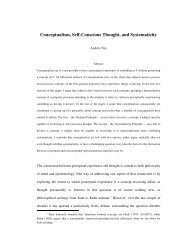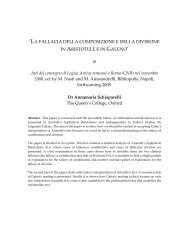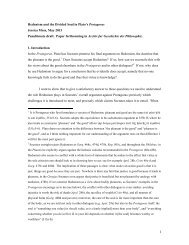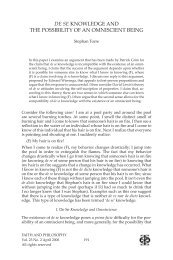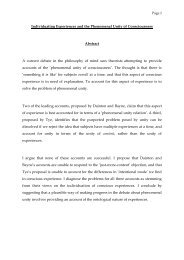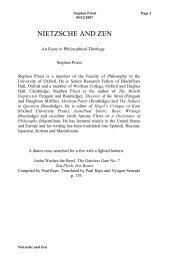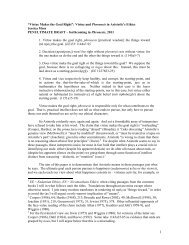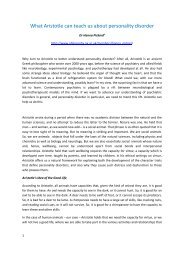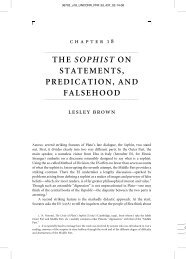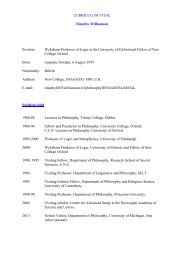In 'Assertion', Robert Stalnaker distinguishes between the sema
In 'Assertion', Robert Stalnaker distinguishes between the sema
In 'Assertion', Robert Stalnaker distinguishes between the sema
Create successful ePaper yourself
Turn your PDF publications into a flip-book with our unique Google optimized e-Paper software.
Assertion, Context, and Epistemic Accessibility 1<br />
John Hawthorne and Ofra Magidor<br />
<strong>In</strong>troduction<br />
<strong>In</strong> this paper we discuss a problem for <strong>the</strong> meta-<strong>sema</strong>ntic framework proposed by <strong>Robert</strong><br />
<strong>Stalnaker</strong>. <strong>In</strong> his seminal paper ‘Assertion’ 2 , <strong>Stalnaker</strong> <strong>distinguishes</strong> <strong>between</strong> <strong>the</strong><br />
<strong>sema</strong>ntic content of a sentence on an occasion of use and <strong>the</strong> content asserted by an<br />
utterance of that sentence on that occasion. <strong>In</strong> general, <strong>the</strong> default option for assertoric<br />
content is <strong>the</strong> <strong>sema</strong>ntic content of <strong>the</strong> utterance, but as <strong>Stalnaker</strong> sees it, <strong>the</strong> mechanisms<br />
of conversation sometimes force <strong>the</strong> two apart. <strong>In</strong> this connection, he outlines some<br />
principles for asserted content that systematize cases of divergence. Central to <strong>Stalnaker</strong>’s<br />
framework is <strong>the</strong> notion of a context of communication, which is roughly <strong>the</strong> set of live<br />
options at each point in a conversation, and a conception of <strong>the</strong> role of assertion as that of<br />
cutting down <strong>the</strong> live options and thus narrowing <strong>the</strong> context. Of special interest in this<br />
connection is one of <strong>the</strong> principles governing assertoric content in <strong>the</strong> framework, one<br />
according to which <strong>the</strong> asserted content ought to be identical at each world in <strong>the</strong> context<br />
set (as we call it, <strong>the</strong> ‘Uniformity’ principle). <strong>In</strong>deed it is Uniformity that explains, for<br />
many cases, why assertoric content comes apart from <strong>sema</strong>ntic content.<br />
<strong>In</strong> this paper we challenge <strong>the</strong> plausibility of this principle by reflecting on its interaction<br />
with <strong>the</strong> facts of epistemic accessibility. <strong>In</strong> particular, we argue that <strong>the</strong> fact that agents<br />
can know propositions without knowing that <strong>the</strong>y know <strong>the</strong>m and fail to know<br />
propositions without knowing that <strong>the</strong>y fail to know <strong>the</strong>m causes serious problems for<br />
that principle and thus, more generally, for <strong>Stalnaker</strong>’s framework. <strong>In</strong> §1, we briefly<br />
introduce <strong>Stalnaker</strong>’s framework. <strong>In</strong> §2, we explain why failures of epistemic<br />
transparency cause a serious problem to <strong>the</strong> principle of Uniformity. <strong>In</strong> §3, we elaborate<br />
on <strong>the</strong> notion of a diagonal content, and suggest that in <strong>the</strong> light of this discussion,<br />
<strong>Stalnaker</strong> might plausibly revert to a weaker version of <strong>the</strong> uniformity principle – <strong>the</strong><br />
1<br />
We are grateful for conversations and comments from Brian Ball, <strong>Robert</strong> <strong>Stalnaker</strong>, and Timothy<br />
Williamson.<br />
2<br />
<strong>Stalnaker</strong> (1999), ch.4 (originally published in 1978).<br />
1
principle we call ‘Weak Uniformity’. However, we show that our argument in §2 can be<br />
generalised to an argument against Weak Uniformity. <strong>In</strong> §4, we show how <strong>the</strong> issues in<br />
question are particularly pressing in <strong>the</strong> light of <strong>the</strong> presence of vague expressions. <strong>In</strong> §5,<br />
we discuss various responses that a proponent of <strong>Stalnaker</strong>’s framework can suggest to<br />
our arguments, and claim that <strong>the</strong>y will not do. <strong>In</strong> §6, we begin by noting our arguments<br />
so far have relied on a knowledge-<strong>the</strong>oretic construal of <strong>the</strong> context set (roughly, <strong>the</strong><br />
worlds in <strong>the</strong> context set are those compatible with <strong>the</strong> participants’ knowledge). We thus<br />
consider whe<strong>the</strong>r <strong>the</strong> arguments can be defused by moving from a knowledge-<strong>the</strong>oretic to<br />
a presupposition-<strong>the</strong>oretic notion of context (roughly, one according to which <strong>the</strong> worlds<br />
in <strong>the</strong> context set those compatible with <strong>the</strong> participants’ presuppositions). We argue that<br />
such a move will not help because presuppositions also suffer from transparency failures,<br />
and thus our arguments can be generalised against <strong>the</strong> presupposition-<strong>the</strong>oretic<br />
framework as well. This concludes <strong>the</strong> core of <strong>the</strong> paper, and our central case against<br />
<strong>Stalnaker</strong>’s framework. <strong>In</strong> a final section, §7, we offer some cursory remarks regarding<br />
<strong>the</strong> underlying rationale for <strong>the</strong> uniformity principle and argue that it is unpersuasive.<br />
§1 Context and assertion<br />
We begin by outlining <strong>the</strong> essentials of <strong>the</strong> framework. According to <strong>Stalnaker</strong>,<br />
conversation takes place against a set of possible worlds called ‘<strong>the</strong> context set’.<br />
<strong>In</strong>tuitively, <strong>the</strong> context set at a time represents those worlds that are considered live<br />
options in <strong>the</strong> conversation at that time. The role of assertion on this picture is to update<br />
<strong>the</strong> context set by ruling out from <strong>the</strong> set all those worlds that are incompatible with <strong>the</strong><br />
asserted content. The content of an assertion is treated as a set of worlds, and update<br />
proceeds by intersection of asserted content (which, on <strong>Stalnaker</strong>’s view, is a set of<br />
possible worlds) with <strong>the</strong> set of worlds with <strong>the</strong> context set, thus producing a new context<br />
set.<br />
Standardly, when a sentence is uttered, its asserted content is its <strong>sema</strong>ntic content – which<br />
is in turn determined by <strong>the</strong> standard compositional mechanisms of <strong>the</strong> language. <strong>In</strong>deed,<br />
<strong>the</strong> default asserted content for an utterance is its <strong>sema</strong>ntic content:<br />
2
Default: Unless <strong>the</strong> principles of rational communication are violated, <strong>the</strong> asserted<br />
content is <strong>the</strong> <strong>sema</strong>ntic content.<br />
However, <strong>Stalnaker</strong> notices that <strong>the</strong>re are settings where, if <strong>the</strong> asserted content were<br />
always <strong>the</strong> <strong>sema</strong>ntic content, assertions that are in fact intuitively felicitous would be<br />
unacceptable. One such case is where <strong>the</strong> <strong>sema</strong>ntic content is true across <strong>the</strong> context set<br />
or false across <strong>the</strong> context set (<strong>the</strong> simplest cases being ones where <strong>the</strong> <strong>sema</strong>ntic content<br />
is ei<strong>the</strong>r necessarily true or necessarily false simpliciter). If <strong>sema</strong>ntic content were<br />
asserted content <strong>the</strong>n it would be pointless to make assertions using sentences with<br />
necessarily true contents (because <strong>the</strong> assertion would have no impact on <strong>the</strong> context set).<br />
Meanwhile assertions with necessarily false <strong>sema</strong>ntic contents would be self-defeating<br />
(because <strong>the</strong>y would remove all worlds from <strong>the</strong> context set and make fur<strong>the</strong>r<br />
communication impossible)<br />
<strong>Stalnaker</strong> thinks that asserted content may come apart from <strong>sema</strong>ntic content even in<br />
cases where <strong>the</strong> <strong>sema</strong>ntic content is contingent across <strong>the</strong> context set. This happens when<br />
<strong>the</strong> <strong>sema</strong>ntic content of an utterance is different at different worlds in <strong>the</strong> context set.<br />
<strong>Stalnaker</strong>’s basic worry is that in such cases, if <strong>sema</strong>ntic content were asserted content, an<br />
audience would not know how to update <strong>the</strong> context set in <strong>the</strong> light of <strong>the</strong> assertion.<br />
Suppose that at some of <strong>the</strong> live options <strong>the</strong> <strong>sema</strong>ntic content rules out a certain world w<br />
but at o<strong>the</strong>rs it does not. Since all options are live, each of <strong>the</strong> <strong>sema</strong>ntic contents is live,<br />
and hence <strong>the</strong> participants in <strong>the</strong> conversation would not know whe<strong>the</strong>r to keep world w<br />
in <strong>the</strong> context set or remove it: <strong>the</strong>y would not be able to discern which worlds were<br />
being knocked out by <strong>the</strong> assertion. Take a simple example. Suppose I know <strong>the</strong>re is only<br />
one person in a certain room, but I don’t know whe<strong>the</strong>r it is Bill or Ben. Someone points<br />
to whoever is in <strong>the</strong> room and asserts ‘He is on fire’. Assuming <strong>sema</strong>ntic orthodoxy, <strong>the</strong>re<br />
is at least one world in <strong>the</strong> context set where <strong>the</strong> <strong>sema</strong>ntic content is <strong>the</strong> proposition that<br />
Ben is on fire, and at least one world where it is <strong>the</strong> proposition that Bill is on fire. Prior<br />
to <strong>the</strong> assertion, <strong>the</strong>re are four relevant classes of live options – ones where Bill is in <strong>the</strong><br />
room and on fire, ones where Bill is in <strong>the</strong> room and not on fire, ones where Ben is in <strong>the</strong><br />
room and on fire, and ones where Ben is in <strong>the</strong> room and not on fire. If asserted content is<br />
3
<strong>sema</strong>ntic content, <strong>the</strong>n three of <strong>the</strong>se classes are ruled out, but while I know two of <strong>the</strong>se<br />
three classes (those where <strong>the</strong> person in <strong>the</strong> room – be it Bill or Ben - is not on fire), I<br />
don’t know which is <strong>the</strong> third class (<strong>the</strong> one where Bill is in <strong>the</strong> room and on fire, or <strong>the</strong><br />
one where Ben is in <strong>the</strong> room and on fire). Hence if asserted content is <strong>sema</strong>ntic content,<br />
<strong>the</strong> audience will be unable to appropriate update <strong>the</strong> context set and so <strong>the</strong><br />
conversational setting will be defective.<br />
To solve this problem, <strong>Stalnaker</strong> introduces a mechanism for selecting an alternative<br />
asserted content where simply going with <strong>the</strong> <strong>sema</strong>ntic content will result in a defect of<br />
this sort. The mechanism is via an operation that <strong>Stalnaker</strong> calls ‘diagonalization’. The<br />
diagonal content of an utterance is a proposition that is true at a world of <strong>the</strong> context set if<br />
<strong>the</strong> <strong>sema</strong>ntic content of <strong>the</strong> utterance at that world is true and false if <strong>the</strong> <strong>sema</strong>ntic content<br />
is false. The case of Bill and Ben is a paradigm case where asserted content is diagonal<br />
content ra<strong>the</strong>r than <strong>sema</strong>ntic content. <strong>In</strong> that scenario, <strong>the</strong> <strong>sema</strong>ntic content of ‘He is on<br />
fire’ is <strong>the</strong> proposition that Ben is on fire at each world in <strong>the</strong> context set that Ben is in<br />
<strong>the</strong> room and <strong>the</strong> proposition that Bill is on fire at each world in <strong>the</strong> context set that Bill is<br />
in <strong>the</strong> room. The diagonal proposition thus delivers <strong>the</strong> value ‘true’ at each world in <strong>the</strong><br />
context set where <strong>the</strong> person in <strong>the</strong> room is on fire and ‘false’ at <strong>the</strong> remaining worlds in<br />
<strong>the</strong> context set. It is thus clear that what <strong>the</strong> audience ought to do, on this model, is to<br />
remove from <strong>the</strong> context set all and only <strong>the</strong> worlds where <strong>the</strong> person in <strong>the</strong> room is on<br />
fire.<br />
The general principle underlying <strong>the</strong> move to diagonalization in such cases is <strong>the</strong><br />
following principle, which we call ‘Uniformity’:<br />
Uniformity: <strong>In</strong> cases of rational communication, <strong>the</strong> same proposition is asserted at each<br />
world in <strong>the</strong> context set. 3<br />
3<br />
<strong>Stalnaker</strong> (1999), p. 88. This is his third principle, modified to make explicit his claim that his<br />
principles are an account of rational communication ra<strong>the</strong>r than an empirical generalization. We have<br />
replaced ‘asserted’ with ‘expressed’ to make <strong>the</strong> content of <strong>the</strong> principle maximally clear.<br />
4
§2 Epistemic accessibility and Uniformity failures<br />
One subtle issue for <strong>the</strong> <strong>Stalnaker</strong> framework concerns <strong>the</strong> determination of <strong>the</strong> context<br />
set. What makes a world a live option in <strong>the</strong> relevant sense? <strong>In</strong> this section we shall<br />
operate with an account of context determination according to which a world is live in a<br />
conversation if it compatible with those propositions that are known by all parties to <strong>the</strong><br />
conversation. Having raised a problem for <strong>the</strong> framework with context understood in this<br />
way, we shall later discuss whe<strong>the</strong>r some o<strong>the</strong>r conceptions of context will evade <strong>the</strong><br />
problem (including iterated knowledge and presupposition based proposals).<br />
The crux of <strong>the</strong> problem is this. <strong>Stalnaker</strong> holds that Uniformity governs rational<br />
communication. <strong>In</strong> cases where <strong>the</strong> <strong>sema</strong>ntic content will not respect Uniformity,<br />
<strong>Stalnaker</strong> reverts to <strong>the</strong> diagonal content. However, this implicitly assumes that moving<br />
to <strong>the</strong> diagonal content will ensure that Uniformity is satisfied. But, as we now argue, this<br />
assumption is unwarranted.<br />
Our argument will rely on failures of transparency for knowledge. That is, it will rely on<br />
cases where one knows p, but one does not know that one knows p, and on cases where<br />
one does not know p, but one does not know that one does not know p. 4 Call a world w 2<br />
‘accessible relative to conversation C’ from a world w 1 if and only if what is known by<br />
all participants in C at w 1 is compatible with w 2 . If knowledge is not transparent, <strong>the</strong>re<br />
could be cases where accessibility relations of this sort are asymmetric, and also cases<br />
where <strong>the</strong>y are intransitive. 5 , 6 Failures of transitivity make for cases like this: There is a<br />
4<br />
The claim that one sometimes does not know without knowing that one does not know is<br />
uncontroversial. (For example, in standard cases of illusion, one thinks one knows some proposition p that<br />
one does not in fact know). As for <strong>the</strong> claim that one sometimes knows without knowing that one knows:<br />
<strong>the</strong> possibility of such cases has been argued for extensively in Williamson (2000). The core line of thought<br />
is that one cannot know that exact limits of what one knows because one knows in general that <strong>the</strong> cases<br />
just beyond <strong>the</strong> limits of what one knows have to match in truth value with <strong>the</strong> proposition that one knows.<br />
If one knew <strong>the</strong> limits of what one knows, <strong>the</strong>y would not <strong>the</strong>n, after all, be <strong>the</strong> limits of what one knows<br />
since one could use those general considerations about <strong>the</strong> limits to push <strong>the</strong>m fur<strong>the</strong>r. We will return to<br />
Williamason’s argument in more detail in §6.<br />
5<br />
We note in passing that even if (per impossibile) knowledge were transparent, <strong>the</strong>n as we set<br />
things up, it is fairly straightforward to construct cases of transitivity failure. Suppose A knows p and<br />
knows that he knows p, and that B knows p and knows that she knows p. But suppose that A does not know<br />
that B knows p and B does not know that A knows p. <strong>In</strong> this setting <strong>the</strong>re will be accessible worlds where<br />
A does not know p (since that is not a proposition that both conversational participants know) and<br />
accessible worlds where B does not know p (for <strong>the</strong> same reason). From those worlds certain worlds where<br />
5
world w 1 , such that <strong>the</strong> context set according to w 1 rules out some world w 3 . However,<br />
<strong>the</strong>re is a world w 2 in <strong>the</strong> context set of w 1 , such that, according to w 2 , <strong>the</strong> conversation<br />
does include w 3 in its context set. Suppose q is incompatible with what is known at w 1<br />
but is not incompatible with anything that is known to be known at w 1 . There will <strong>the</strong>n be<br />
a q-world w 3 that is inaccessible from w 1 but is accessible from a world w 2 that is<br />
accessible from w 1 . <strong>In</strong> this scenario, w 3 will be in <strong>the</strong> context set of <strong>the</strong> conversation at w 2<br />
but not in that of w 1 .<br />
Failures of symmetry make for cases like this: There is a world w 1 such that a world w 2 is<br />
part of <strong>the</strong> context set of w 1 , but such that from <strong>the</strong> perspective of w 2 , w 1 is not part of <strong>the</strong><br />
context set. <strong>In</strong> such a case, w 2 will be epistemically accessible from w 1 (relative to <strong>the</strong><br />
conversation) but w 1 will not be accessible from w 2 .<br />
Let us see how <strong>the</strong>se phenomena make trouble for Uniformity. Return to our example of<br />
Bill and Ben. First, let us exploit symmetry violations. Suppose we don’t know whe<strong>the</strong>r<br />
it is Bill or Ben in <strong>the</strong> room, but for all we know, we know that it is Bill in <strong>the</strong> room.<br />
Then <strong>the</strong>re is an epistemically accessible world w 2 , i.e., a world in our context set, such<br />
that in all worlds in <strong>the</strong> context set of w 2 it is Bill in <strong>the</strong> room. Suppose a participant in<br />
<strong>the</strong> conversation now says ‘He is on fire’, referring to <strong>the</strong> person in <strong>the</strong> room. For reasons<br />
given above, <strong>the</strong> asserted content is not <strong>the</strong> <strong>sema</strong>ntic content but <strong>the</strong> diagonal content:<br />
Uniformity would be violated by asserting <strong>the</strong> <strong>sema</strong>ntic content in this case. Consider<br />
now <strong>the</strong> asserted content of <strong>the</strong> same utterance at w 2 . As opposed <strong>the</strong> actual world,<br />
relative to w 2 , <strong>the</strong> <strong>sema</strong>ntic content of <strong>the</strong> utterance is uniform across all world in its<br />
not-P holds will be accessible (since p is not known by both participants at those worlds). One way of<br />
trying to handle this is by crafting a conception of <strong>the</strong> context set in terms of mutual iterated knowledge<br />
(more on this later). Ano<strong>the</strong>r is to treat such contexts as defective on account of a mismatch <strong>between</strong> what<br />
<strong>the</strong> participants know that relevant to <strong>the</strong> discussion. (Relevant here is <strong>Stalnaker</strong> (1999), p. 85).<br />
6<br />
More accurately, failures of <strong>the</strong> principle that says that if one knows p <strong>the</strong>n one knows that one<br />
knows p ensure that <strong>the</strong> accessibility relation is not transitive. Failures of <strong>the</strong> principle that if one does not<br />
know p <strong>the</strong>n one knows that one does not know p entail that <strong>the</strong> accessibility relation is not Euclidean, i.e.<br />
that <strong>the</strong>re are three words w 1 , w 2 , and w 3 , such that w 2 and w 3 are both accessible from w1, but such that<br />
one of w 2 and w 3 is not accessible from <strong>the</strong> o<strong>the</strong>r. Given <strong>the</strong> reflexivity of knowledge, symmetry and<br />
transitivity failures will each entail a Euclideanality failure, but not necessarily vice versa. It’s worth<br />
noting, however, that any kind of Euclideanality failure has <strong>the</strong> structure that we need for our argument:<br />
namely, that <strong>the</strong>re are three worlds w 1 , w 2 , and w 3 , such that w 2 and w 3 are both in <strong>the</strong> context set of w 1 but<br />
one of w 2 and w 3 is not in <strong>the</strong> context set of <strong>the</strong> o<strong>the</strong>r.<br />
6
context set: It is always <strong>the</strong> proposition that Bill is on fire. Given Default, this means that<br />
<strong>the</strong> asserted content at w 2 is simply <strong>the</strong> proposition that Bill is on fire. But this in turn<br />
entails that <strong>the</strong> asserted content at <strong>the</strong> actual world is different to <strong>the</strong> asserted content at<br />
w 2 . Thus we violate Uniformity even by asserting <strong>the</strong> Diagonal proposition since at o<strong>the</strong>r<br />
worlds in <strong>the</strong> context set, Default will not be trumped and hence <strong>the</strong> Semantic content of<br />
<strong>the</strong> utterance at that world will be asserted. It thus turns out that whe<strong>the</strong>r we assert <strong>the</strong><br />
<strong>sema</strong>ntic content or <strong>the</strong> diagonal content we will violate Uniformity.<br />
Next, let us exploit transitivity violations. Suppose we know it is Bill in <strong>the</strong> room but do<br />
not know that we know. There is some epistemically accessible world w 2 -- i.e. a world in<br />
our context set – where it is unknown whe<strong>the</strong>r Bill or Ben is in <strong>the</strong> room. Someone<br />
actually utters ‘He is on fire’. Given that all worlds in <strong>the</strong> context set are such that Bill is<br />
in <strong>the</strong> room, <strong>the</strong> <strong>sema</strong>ntic content will be uniform across <strong>the</strong> context set and hence, given<br />
that <strong>the</strong>re are no o<strong>the</strong>r salient counterveiling considerations to Default, <strong>the</strong> asserted<br />
content will be <strong>the</strong> <strong>sema</strong>ntic content. Consider now <strong>the</strong> asserted content of <strong>the</strong> utterance<br />
at w 2 . The context set at w 2 includes some worlds where <strong>the</strong> <strong>sema</strong>ntic content of <strong>the</strong><br />
utterance concerns Bill and also some worlds where <strong>the</strong> <strong>sema</strong>ntic content of <strong>the</strong> utterance<br />
concerns Ben. Hence, by <strong>Stalnaker</strong>’s proposed mechanism, <strong>the</strong> asserted content at w 2 will<br />
be <strong>the</strong> diagonal content. But now, once again, Uniformity is violated for <strong>the</strong> asserted<br />
content in <strong>the</strong> actual world is <strong>the</strong> proposition that Bill is on fire, while at certain worlds in<br />
<strong>the</strong> context set, <strong>the</strong> asserted content is a different, Diagonal, proposition.<br />
§3 Diagonal propositions and Weak Uniformity<br />
<strong>In</strong> our initial presentation, we followed <strong>Stalnaker</strong> in talking of ‘<strong>the</strong> Diagonal proposition’<br />
of an utterance. However, this is strictly speaking misleading. As we have laid things out<br />
thus far, we have only specified how diagonal content behaves with respect to worlds<br />
within <strong>the</strong> context set: at each of those worlds, <strong>the</strong> diagonal content is true if <strong>the</strong> <strong>sema</strong>ntic<br />
content expressed at that world is true and false o<strong>the</strong>rwise. But this specification is<br />
completely silent as to how <strong>the</strong> so-called diagonal is to behave outside <strong>the</strong> context set.<br />
Thus, strictly speaking, we should talk about a diagonal proposition, not <strong>the</strong> diagonal<br />
proposition. A diagonal proposition is one that confirms to <strong>the</strong> diagonal recipe for <strong>the</strong><br />
7
worlds in <strong>the</strong> context set. Now <strong>Stalnaker</strong>’s own attitude seems to be that since it never<br />
matters what <strong>the</strong> truth value is outside <strong>the</strong> context set, it never matters which diagonal<br />
proposition one is asserting:<br />
Don’t Care: <strong>In</strong> cases of rational communication where <strong>the</strong> asserted content is not <strong>the</strong><br />
<strong>sema</strong>ntic content, it is unimportant which diagonal proposition one asserts. 7<br />
This relaxed attitude shows that <strong>Stalnaker</strong> should not be fully committed to Uniformity<br />
but ra<strong>the</strong>r to a weaker version of it: 8<br />
Weak Uniformity: <strong>In</strong> cases of rational communication, <strong>the</strong> propositions asserted at each<br />
world in <strong>the</strong> context set agree in truth-value with respect to all worlds in <strong>the</strong> context set.<br />
But <strong>the</strong> structural features of epistemic accessibility that we have been working with<br />
render this combination unstable. <strong>In</strong> connection with symmetry violations, take a version<br />
of <strong>the</strong> first case described in §2, where as a matter of fact Ben is in <strong>the</strong> room. Then <strong>the</strong>re<br />
will be a world in <strong>the</strong> context set where <strong>the</strong> proposition asserted – that Bill is in <strong>the</strong> room<br />
– is false at <strong>the</strong> actual world, but where <strong>the</strong> proposition actually asserted – a diagonal<br />
content – is true at <strong>the</strong> actual world. Here, <strong>the</strong>n, <strong>the</strong>re is a clash <strong>between</strong> Default and<br />
Weak Uniformity.<br />
<strong>In</strong> connection with transitivity violations, consider a case where I know ei<strong>the</strong>r Bill or Ben<br />
is in <strong>the</strong> room, but I don’t know which and fur<strong>the</strong>r, that for all I know that I know, I know<br />
it is Ben or Tim that is in <strong>the</strong> room. I cannot assert <strong>the</strong> <strong>sema</strong>ntic content at <strong>the</strong> actual<br />
world, for familiar reasons. <strong>Stalnaker</strong> recommends that I assert a diagonal proposition but<br />
reassures me that it doesn’t matter which. Suppose <strong>the</strong>n I actually assert <strong>the</strong> proposition<br />
that Bill or Ben is on fire by ‘He is on fire’. There is world w 2 in my context set where<br />
<strong>the</strong> context set at w 2 includes worlds where ei<strong>the</strong>r Ben or Tim is in <strong>the</strong> room, and where<br />
7<br />
Note that where <strong>the</strong> <strong>sema</strong>ntic content is <strong>the</strong> asserted content, <strong>the</strong> <strong>sema</strong>ntic content is a diagonal<br />
proposition. But Default tells us that in this case it does matter which proposition one asserts.<br />
8<br />
<strong>Stalnaker</strong>’s preference for Weak Uniformity is confirmed by a footnote in ‘Assertion’ (see<br />
<strong>Stalnaker</strong> (1999), p. 91, f.n. 13 and is reiterated in <strong>Stalnaker</strong> (2006), p. 297.<br />
8
for familiar reasons <strong>the</strong> asserted content of my utterance relative to w 2 cannot be <strong>the</strong><br />
<strong>sema</strong>ntic content. <strong>Stalnaker</strong> recommends that at w 2 <strong>the</strong> assertor expresses a diagonal<br />
proposition but that it doesn’t matter which. Suppose <strong>the</strong> proposition asserted at w 2 is that<br />
Ben or Tim is on fire. Finally let us suppose that in <strong>the</strong> actual world, Bill is in <strong>the</strong> room<br />
and on fire. Now Weak Uniformity is violated, since <strong>the</strong> proposition asserted in <strong>the</strong> actual<br />
world is true at <strong>the</strong> actual world but <strong>the</strong> proposition asserted at <strong>the</strong> Ben-Tim world w 2 is<br />
false at <strong>the</strong> actual world.<br />
§4 Vagueness<br />
The reflections of <strong>the</strong> previous sections have an interesting application to cases where<br />
one makes an assertion containing a vague expression. To see how <strong>Stalnaker</strong>’s<br />
framework interacts with vague utterances, we first need to fix on a <strong>the</strong>ory of <strong>the</strong><br />
<strong>sema</strong>ntic content for vague predicates. We shall consider <strong>the</strong> two most prominent <strong>the</strong>ories<br />
– epistemicism and supervaluationism – and show that <strong>the</strong> framework runs into trouble<br />
for reasons tightly connected to <strong>the</strong> structural considerations discussed above.<br />
Let us first consider a standard epistemicist story. The actual <strong>sema</strong>ntic content of a vague<br />
utterance such as ‘Bill is tall’ is a content that satisfies both excluded middle and<br />
bivalence. <strong>In</strong> a borderline case, we do not know whe<strong>the</strong>r <strong>the</strong> content is true, and this<br />
ignorance has a distinctive source: at close worlds, imperceptibly different from <strong>the</strong><br />
actual world, <strong>the</strong> utterance expresses a slightly different content that disagrees in truth<br />
value with regard to <strong>the</strong> case at hand. (<strong>In</strong> non-borderline cases <strong>the</strong>re is this variation in<br />
content across close worlds as well, but <strong>the</strong> contents need not disagree in truth-value).<br />
As a toy model let us assume that in each world, if <strong>the</strong> sharp cut-off point for ‘tall’ is N<br />
<strong>the</strong>n in all epistemically accessible worlds <strong>the</strong> cut-off is ei<strong>the</strong>r N or N plus one cm or N<br />
minus one cm. A model of this sort explains unknowability in borderline cases and<br />
generates a margin for error principle for vague predicates. 9 Suppose that <strong>the</strong> (unknown)<br />
sharp cut-off for ‘tall’ in <strong>the</strong> actual world is 1.8m. Given our model, this means that in<br />
epistemically possible worlds, <strong>the</strong> cut-off point for ‘tall’ has one of <strong>the</strong> three values:<br />
9<br />
See Williamson (1994), particularly ch. 8.<br />
9
1.79m, 1.8m, and 1.81m. Suppose <strong>the</strong> context set prior to my assertion is one where<br />
Bill’s height is unknown. I discover he is 1.82m and exclaim ‘Bill is tall’. If <strong>the</strong> content<br />
of my assertion is <strong>the</strong> <strong>sema</strong>ntic content <strong>the</strong>n Weak Uniformity is violated. So, by<br />
<strong>Stalnaker</strong>’s lights, I assert a diagonal proposition and given Don’t Care, it doesn’t matter<br />
which.<br />
Now consider a world in <strong>the</strong> context set where <strong>the</strong> sharp cut-off for ‘tall’ is 1.79m. Given<br />
our model, epistemically accessible worlds from that world will have a different profile to<br />
<strong>the</strong> actual case: <strong>the</strong>y will include worlds where <strong>the</strong> cut-off is restricted to <strong>the</strong> values<br />
1.78m, 1.79m, and 1.8m. At that world, for familiar reasons, asserted content will not be<br />
<strong>sema</strong>ntic content, but ra<strong>the</strong>r a diagonal content. However given that <strong>the</strong> set of worlds in<br />
<strong>the</strong> context set at that world do not include all of <strong>the</strong> worlds in <strong>the</strong> actual context set, <strong>the</strong><br />
worlds that fall within <strong>the</strong> ambit of Don’t Care for inhabitants of that world will include<br />
some worlds (namely those in which <strong>the</strong> cut-off is 1.81m) that fall within <strong>the</strong> actual<br />
context set. It is now an easy matter to construct a diagonal proposition for members of<br />
that world that differs from <strong>the</strong> diagonal proposition actually asserted (for example, given<br />
Don’t Care, we can assert a diagonal at <strong>the</strong> 1.79 cut-off world that it is true if and only if<br />
Bill is above 1.9m at <strong>the</strong> 1.81m worlds. Our actual assertion of ‘Bill is tall’ is true at <strong>the</strong><br />
1.81m cut-off worlds, but that 1.79m-world assertion is false at <strong>the</strong> 1.81m cut-off<br />
worlds). The upshot is that Weak Uniformity will be violated.<br />
A similar story will apply to supervaluationism. Without going into details, that<br />
framework posits a range of acceptable precisifcations for a predicate at a world, without<br />
privileging any one of <strong>the</strong>m <strong>sema</strong>ntically. <strong>In</strong> this setting, let us think of <strong>the</strong> meaning of a<br />
predicate as given by its range of acceptable precifications. Our use somehow determines<br />
a range of acceptable precisifications. It has to be allowed, course, that small,<br />
imperceptible differences in use sometimes makes for small differences in <strong>the</strong> range of<br />
acceptable precifications (After all, one can construct a series of cases, with each adjacent<br />
case imperceptibly different but where <strong>the</strong> meanings of <strong>the</strong> cases at each end are wildly<br />
different. So small differences have to make a difference in meaning). The upshot is that,<br />
within <strong>the</strong> context set, <strong>the</strong> meaning of a vague predicate will not be constant. Moreover,<br />
<strong>the</strong>re will be worlds that are just far enough away from <strong>the</strong> actual world to be outside <strong>the</strong><br />
1
context set but close enough to some worlds within <strong>the</strong> context set to be within <strong>the</strong><br />
context set of inhabitants at that world. With this structure in place, <strong>the</strong> preceding<br />
considerations apply: Worlds that we care about in <strong>the</strong> actual world will count as don’t<br />
cares relative to o<strong>the</strong>r worlds in <strong>the</strong> context set and hence Weak Uniformity will fail.<br />
§5 Variations on <strong>the</strong> knowledge-<strong>the</strong>oretic framework<br />
<strong>In</strong> this section and <strong>the</strong> next, we will briefly consider various ways in which <strong>the</strong> proponent<br />
of a broadly <strong>Stalnaker</strong>ian framework might try to respond to our argument. We assume,<br />
as before, that it is hopeless to defend <strong>the</strong> transparency of knowledge.<br />
One response we have encountered is to use iterated knowledge to define <strong>the</strong> context set.<br />
Let us say that we know* p if and only if we know p and we know that we know p and so<br />
on. Let a world belong to <strong>the</strong> context set if and only if it is not incompatible with what we<br />
know*. Using know* to define <strong>the</strong> context set is a brute force method for responding to<br />
<strong>the</strong> cases discussed earlier that turn on transitivity failure.<br />
This response is dissatisfying for a variety of reasons. First, if KK fails, <strong>the</strong>re may be<br />
hardly anything that we know*, since each iteration brings fresh epistemic demands with<br />
it. Defining <strong>the</strong> context set by know* thus risks making <strong>the</strong> context set enormous,<br />
extending far beyond what intuitively count as <strong>the</strong> ‘live options’ in a conversation.<br />
Second, and relatedly, it is not plausible that when someone asserts something we come<br />
to know* <strong>the</strong> proposition that <strong>the</strong>y assert. Even if we come to know that content, know*<br />
is (assuming <strong>the</strong> failure of KK) so demanding that we may well fail to know* what is<br />
asserted. If <strong>the</strong> context set is defined by knowing* <strong>the</strong>n assertion will rarely do <strong>the</strong> job<br />
that <strong>the</strong> Stalnakarian asks of it, namely that of narrowing <strong>the</strong> context set. Third, while <strong>the</strong><br />
move to knowing* speaks to <strong>the</strong> original cases that turn on failures of transitivity, it does<br />
not address cases that turn on failures of symmetry. 10<br />
10<br />
There are o<strong>the</strong>r ways of trying to use iterated knowledge to solve <strong>the</strong> problem. But <strong>the</strong>y all fail for<br />
reasons that should, by now, be unsurprising. Suppose we took <strong>the</strong> context set to be given by what we<br />
know we know and defined <strong>the</strong> context set by what is compatible with that second level knowledge. This<br />
helps with one problem with know*: while we hardly know* anything, <strong>the</strong>re is arguably quite a bit that<br />
participants in a conversation know that <strong>the</strong>y know. But it doesn’t help with <strong>the</strong> problem of symmetry<br />
failures. Moreover, and importantly, <strong>the</strong> main arguments of <strong>the</strong> paper will apply straightforwardly to cases<br />
1
<strong>In</strong> response, <strong>the</strong> <strong>Stalnaker</strong>ian might defend himself by conceding that we hardly ever<br />
know* anything but maintain that his description of rational communication is a<br />
permissible idealization. He might remind us that, after all, idealizations are quite<br />
common in decision <strong>the</strong>ory and game <strong>the</strong>ory (for example, <strong>the</strong>orizing in that setting often<br />
assumes logical omniscience), and presumably that is often quite justifiable for <strong>the</strong><br />
purposes at hand. Can’t an invocation of knowledge* be justified in a similar way?<br />
A blanket appeal to <strong>the</strong> acceptability of idealization is not satisfying here. Idealizations<br />
are most saliently permissible where real world rational agents approximate <strong>the</strong> situation<br />
described in <strong>the</strong> idealization in a way that makes <strong>the</strong> decision <strong>the</strong>ory a good guide to how<br />
real world rational agents ought to proceed. But it is not clear that <strong>the</strong> Stalnakarian<br />
framework is useful to real world communicants in this way. The central line of thought<br />
demanding uniformity – one that claimed that hearers would not know how to proceed if<br />
uniformity were violated – would not be assuaged if speakers only approximated<br />
uniformity. More generally, <strong>Stalnaker</strong>ian arguments that divorce asserted content from<br />
<strong>sema</strong>ntic content assume strict compliance with uniformity (at least on its weaker<br />
version), not merely approximate compliance. 11 Meanwhile that framework is utterly<br />
silent about what to do in cases where both <strong>sema</strong>ntic content and diagonal content violate<br />
uniformity. If <strong>the</strong> norm ‘approximate uniformity’ is to guide us in those cases, it needs<br />
fur<strong>the</strong>r articulation and motivation.<br />
where second level knowledge is not transparent. Suppose instead we took second level knowledge to be<br />
crucial, but defined <strong>the</strong> context set not by what is compatible with second level knowledge but instead by<br />
stipulating that <strong>the</strong> context set for a world w (relative to a conversation and time) are those worlds where<br />
<strong>the</strong> second level knowledge is exactly <strong>the</strong> same as in w. This has <strong>the</strong> drawback of detaching <strong>the</strong> notion of<br />
context set from <strong>the</strong> intuitive notion of what is a live option. For in those cases where <strong>the</strong>re is second level<br />
knowledge but it is not known whe<strong>the</strong>r or not it is present, it will be a live option, intuitively, <strong>the</strong>re is no<br />
such second level knowledge.<br />
11<br />
While we cannot enter at length into <strong>the</strong> relevant debates, it bears emphasis that even <strong>the</strong><br />
idealizations of standard decision <strong>the</strong>ories may in some cases be deeply problematic. If failures of<br />
transparency are a pervasive feature of our epistemic lives, normative guidance that is insensitive to such<br />
failures may in some cases turn out to be poor guidance. A decision <strong>the</strong>oretic framework that was<br />
altoge<strong>the</strong>r inapplicable to beings for whom transparency failed would not provide a good guide for<br />
epistemic updating. Given that an account of <strong>the</strong> dynamics of rational epistemic lives in <strong>the</strong> individual case<br />
ought not to assume transparency, wouldn’t it be ra<strong>the</strong>r strange to insist on it in <strong>the</strong> communal case?<br />
1
A second possible response is to give up Don’t Care: in those cases where <strong>the</strong> rules<br />
governing rational conversation mean that <strong>the</strong> asserted content is a diagonal proposition,<br />
it is not just any diagonal proposition that we assert, but a particular one. The most<br />
plausible proposal of this sort recommends that asserted content in such cases ought to be<br />
<strong>the</strong> ‘superdiagonal proposition’, one that is true at a world if and only if that utterance<br />
expresses a true <strong>sema</strong>ntic content at that world and is false at a world if and only if <strong>the</strong><br />
utterance expresses a false <strong>sema</strong>ntic content at that world. 12 (Preference for<br />
superdiagonals is motivated by <strong>the</strong> need to ensure that <strong>the</strong> asserted content is uniform<br />
even where <strong>the</strong> facts of epistemic accessibility differ.) The proposal needs refinement.<br />
After all, <strong>the</strong>re are worlds where <strong>the</strong> utterance does not exist. What does <strong>the</strong> so-called<br />
superdiagonal of <strong>the</strong> actual utterance have to say about those? Ignoring certain<br />
complications, let us allow a don’t care attitude about those worlds. 13<br />
<strong>In</strong> response, note first that this does not help with all of our cases. Recall cases of<br />
symmetry violation where in <strong>the</strong> actual world we assert a diagonal but at an epistemically<br />
accessible world we assert <strong>the</strong> <strong>sema</strong>ntic content. <strong>In</strong> such cases, refined advice about<br />
which diagonal to assert will not restore Weak Uniformity. Second, insofar as we are<br />
permitted any intuitive fix at all on <strong>the</strong> asserted content, <strong>the</strong> proposal will lead to wildly<br />
unintuitive consequence. If I assert ‘He is on fire’ <strong>the</strong>re is some possible world where <strong>the</strong><br />
sounds I produce have <strong>the</strong> <strong>sema</strong>ntic content that <strong>the</strong>re are three goldfish in <strong>the</strong><br />
room. 14 According to <strong>the</strong> superdiagonal proposal, my asserted content has no more to do<br />
with fire than it has to do with goldfish. Sure enough, <strong>the</strong> proposal can explain why I get<br />
12<br />
Note that it will not help to replace Don’t Care with an injunction to always assert <strong>the</strong> diagonal<br />
that goes undefined at worlds outside <strong>the</strong> context set. For consider a case where a world w 2 is in my context<br />
set but outside <strong>the</strong> context set of a world w1 in my context set. Then what I assert will be defined at w 2 , but<br />
what is asserted at w1 will be undefined at w 2 . No fur<strong>the</strong>r weakening of Weak Uniformity will preserve its<br />
original spirit here. As what I actually assert will be true in some cases, false in o<strong>the</strong>rs, <strong>the</strong> situation<br />
described would, by <strong>Stalnaker</strong>’s lights, generate an ‘I don’t know what to do’ dilemma of exactly <strong>the</strong> type<br />
that his framework was trying to avoid.<br />
13<br />
One such complication is if <strong>the</strong>re are cases where a sentence is uttered but it is not known whe<strong>the</strong>r<br />
it is, or if a sentence is not uttered but this is not known. (see also <strong>Stalnaker</strong> (2006), p. 301 for a short note<br />
on this issue).<br />
14<br />
One might try to insist that while similar noises are made, it is not <strong>the</strong> same utterance. Note that it<br />
will not do here to insist that difference in <strong>sema</strong>ntic content makes for difference in utterance, since <strong>the</strong><br />
whole framework relies on <strong>the</strong> epistemic accessibility of cases where <strong>the</strong> <strong>sema</strong>ntic content varies. Note also<br />
that insofar as one takes seriously <strong>the</strong> numerical identity and difference of utterances, one will be forced by<br />
Sorites-style considerations to allow that <strong>the</strong>re are cases where some worlds in <strong>the</strong> context set contain a<br />
numerically different utterance to <strong>the</strong> actual utterance.<br />
1
fire-<strong>the</strong>oretic information – namely by intersecting <strong>the</strong> assertion with <strong>the</strong> context set.<br />
Never<strong>the</strong>less, our intuitive sense that <strong>the</strong> assertion has itself something to do with fire<br />
ra<strong>the</strong>r than goldfish is blatantly violated.<br />
Ano<strong>the</strong>r option is to drop Default. But it should be clear that this move will not help with<br />
cases that turn on transitivity violation, since in <strong>the</strong>se cases all <strong>the</strong> asserted contents were<br />
non-<strong>sema</strong>ntic, and thus no appeal was made to Default. <strong>In</strong> order to be responsive to <strong>the</strong><br />
arguments, one would need to drop both Default and Don’t Care, instituting a general<br />
policy to superdiagonalize. This proposal would address both symmetry and transitivity<br />
failures. But it is still highly problematic. First, <strong>the</strong> concern that superdiagonal content is<br />
counterintuitive remains. But <strong>the</strong>re is a second, perhaps deeper worry. Superdiagonal<br />
content is constructed out of <strong>sema</strong>ntic content. It thus assumes <strong>the</strong> reality of <strong>sema</strong>ntic<br />
content. But on <strong>the</strong> current proposal, <strong>sema</strong>ntic content is never asserted. It is surely ra<strong>the</strong>r<br />
troubling to insist on <strong>the</strong> reality of <strong>sema</strong>ntic content but detach it altoge<strong>the</strong>r from <strong>the</strong> facts<br />
about what is asserted. 15<br />
§6 Replacing knowledge with presuppositions<br />
One might think that <strong>the</strong> problems that we have been discussing can be solved by<br />
dropping our simplifying assumption that <strong>the</strong> context set is delivered by <strong>the</strong> facts about<br />
what is known. This is particularly pertinent, since <strong>Stalnaker</strong> himself explicitly distances<br />
himself from <strong>the</strong> <strong>the</strong>sis that a world belongs to a context set if and only if it is<br />
incompatible with what is known. He tells us that we regularly assume certain<br />
propositions for <strong>the</strong> purposes of a conversation even though those propositions are not<br />
known. <strong>In</strong> such cases, he wants to treat worlds incompatible with <strong>the</strong> assumptions as<br />
outside <strong>the</strong> context set even if <strong>the</strong>y are compatible with what is known.<br />
The core attitudinal state in <strong>Stalnaker</strong>’s own presentation is that of presupposition. He<br />
does not define it in terms of more primitive ideology. Ra<strong>the</strong>r he takes it to be a<br />
fundamental mental state, constituted ultimately by speakers’ dispositions. The central<br />
15<br />
p. 297.<br />
This objection to dropping Default is supported by <strong>Stalnaker</strong>. See for example <strong>Stalnaker</strong> (2006),<br />
1
idea is that to presuppose something in a conversation is to take it for granted in that<br />
conversation. 16 Can <strong>Stalnaker</strong> avoid our problems by defining <strong>the</strong> context set in terms of<br />
presupposition and insisting that while knowledge is not transparent presupposition is? If<br />
<strong>the</strong> transparency of a state is taken to require that one always knows whe<strong>the</strong>r or not one is<br />
in that state <strong>the</strong>n one hardly avoids <strong>the</strong> problem. As Williamson indicates, <strong>the</strong> sorts of<br />
considerations that show that knowledge is not transparent in this sense show that no nontrivial<br />
condition is such that one is in a position to know one is in it whenever one is in it,<br />
and is such that one is in a position to know one is not in it whenever one is not in it. For<br />
his part <strong>Stalnaker</strong> assumes that presupposition is transparent in exactly this sense. 17 (That<br />
<strong>Stalnaker</strong> confidently makes this assumption in some places is especially surprising given<br />
that in o<strong>the</strong>rs he talks in language that strongly suggests that presupposition is not<br />
transparent. For example: “A person’s presuppositions are <strong>the</strong> presuppositions that he<br />
takes for granted, often unconsciously…. They are <strong>the</strong> background assumptions that may<br />
be used without being spoken – sometimes without being noticed.” 18 ) Hence, pending<br />
some adequate response to <strong>the</strong> relevant arguments, an assumption of transparency is<br />
unwarranted, and <strong>the</strong> concerns of this paper for <strong>Stalnaker</strong>’s framework remain when <strong>the</strong><br />
context set is defined in terms of presupposition ra<strong>the</strong>r than knowledge.<br />
One might try to avoid <strong>the</strong> problem by trying to cash out <strong>the</strong> relevant notion of<br />
transparency in terms of second level presuppositions. If <strong>the</strong> context set is defined as<br />
those worlds compatible with our presuppositions in a context, <strong>the</strong>n perhaps it is not<br />
important that <strong>the</strong> state of presupposition is transparent in <strong>the</strong> sense that its presence or<br />
absence be knowable, but ra<strong>the</strong>r that it be transparent in <strong>the</strong> sense that its presence or<br />
16<br />
There are special cases where for <strong>the</strong> purposes of conversation we assume something we know to<br />
be false. As for <strong>the</strong> more standard cases, <strong>Stalnaker</strong> sometimes glosses our presuppositions as what each of<br />
us believe all of us believe (on his terminology, ‘common belief’), sometimes as what each of us believes<br />
to be <strong>the</strong> common beliefs, sometimes as what each of us know that all of us know (‘common knowledge’),<br />
sometimes what each of us believe is common knowledge (believed common knowledge). (See for<br />
example, <strong>Stalnaker</strong> (1973). Note that this vacillation is very understandable since in <strong>the</strong> normal case our<br />
beliefs about what o<strong>the</strong>rs believe is based in large part on what we believe o<strong>the</strong>rs know.) Whichever is<br />
ultimately his preferred gloss, it is clear that it is supposed to line up with what intuitively count as <strong>the</strong> live<br />
options in a conversation. Once anti-luminosity arguments are conceded, none of <strong>the</strong>se complex conditions<br />
are going to be transparent in <strong>the</strong> knowledge-<strong>the</strong>oretic sense. Moreover, as we shall see soon, it is<br />
implausible to think <strong>the</strong>se states are transparent in <strong>the</strong> presupposition-<strong>the</strong>oretic sense.<br />
17<br />
This assumption is made explicit in ‘On <strong>the</strong> Representation of Context’, pp. 99-100 in <strong>Stalnaker</strong><br />
(1999).<br />
18<br />
<strong>Stalnaker</strong> (1973), p. 447.<br />
1
absence be presupposed. Granted it may be initially tempting to think that if I presuppose<br />
something, I presuppose that I presuppose it. But it is also initially tempting to think that<br />
if I know something <strong>the</strong>n I know that I know it. As it turns out, both initially tempting<br />
thoughts cannot be true and for similar reasons.<br />
We presented Williamson’s line of thought in informal terms earlier. Let us look at a<br />
more careful (and faithful) version of <strong>the</strong> argument. Suppose someone knows that a tree<br />
is less than 100 centimetres tall by exercising visual discrimination from a distance.<br />
Given known limitations in human vision, <strong>the</strong> following margin for error principle seems<br />
to be something that <strong>the</strong> person knows about himself in that situation:<br />
(MEK) If <strong>the</strong> tree is N centimetres tall, <strong>the</strong> person is unable to know (from his current<br />
position, no matter how much reasoning he indulges in) that <strong>the</strong> tree is less than N+1<br />
centimetres tall.<br />
Suppose fur<strong>the</strong>r that <strong>the</strong> KK principle (roughly, if one knows p <strong>the</strong>n one is in a position to<br />
know that one knows p) were true and that knowledge can be always extended by<br />
deduction. Given KK, <strong>the</strong> person knows that he knows that <strong>the</strong> tree is less than 100<br />
centimetres tall (we can assume that <strong>the</strong> person has reflected on <strong>the</strong> question of whe<strong>the</strong>r<br />
he knows, and that all o<strong>the</strong>r such conditions that an application of <strong>the</strong> KK principle<br />
requires are satisfied in this case). He can <strong>the</strong>n use <strong>the</strong> premise that he knows that <strong>the</strong> tree<br />
is less than 100 centimetres tall along with <strong>the</strong> margin for error principle in a deduction<br />
from known premises to <strong>the</strong> conclusion that <strong>the</strong> tree is not 100 centimetres tall, i.e. that it<br />
is less than 99 centimetres tall. Given KK he knows that he knows than <strong>the</strong> tree is less<br />
than 99 centimetres tall. Now he can repeat <strong>the</strong> procedure. We are led to <strong>the</strong> absurd<br />
conclusion than he can know something false.<br />
Let us see how a very similar style of argument applies to presupposition. Suppose<br />
someone presupposes that a tree is less than 100 centimetres tall. Assume a PP principle:<br />
PP: If one presupposes q, one presupposes that one presupposes that q.<br />
1
We will also assume <strong>the</strong> following principles. First,<br />
Closure: Presupposition is closed under entailment. If one presupposes each of q 1 … q n ,<br />
and q 1 ,….,q n entail r <strong>the</strong>n one presupposes r.<br />
Note that closure is uncontroversial in <strong>the</strong> Stalnakarian framework: it simply follows<br />
from <strong>Stalnaker</strong>’s representation of <strong>the</strong> contents of presuppositions as sets of possible<br />
worlds.<br />
We shall also assume plausible that one in general presupposes that one’s presuppositions<br />
are appropriate:<br />
Propriety: If one presupposes that one presupposes q, <strong>the</strong>n one presupposes that one<br />
acceptably presupposes q.<br />
Finally we need a margin for error principle for presuppositions. <strong>In</strong> a setting such as<br />
above, where a tree is being discussed from a perceptual distance,<br />
MEP A rational agent will presuppose that if <strong>the</strong> tree is N centimetres tall, it is not<br />
acceptable for him to presuppose that it is less than N+1 centimetres tall. 19<br />
By PP, one presupposes that one presupposes that <strong>the</strong> tree is less than 100 centimetres<br />
tall. By Propriety, one presupposes that it is acceptable to presuppose to that <strong>the</strong> tree is<br />
less than 100 centimetres tall. By Closure and MEP, one presupposes that it is not <strong>the</strong><br />
case that <strong>the</strong> tree is exactly 99 centimetres tall. By closure again, one presupposes that <strong>the</strong><br />
tree is less than 99 centimetres tall. But now again <strong>the</strong> argument generalizes to an absurd<br />
conclusion.<br />
We conclude that just as KK is unacceptable, it is equally unacceptable to endorse an<br />
analogous principle of iteration for presupposition. Given <strong>the</strong> failure of PP, our<br />
arguments cannot be blocked simply by shifting to a presupposition-<strong>the</strong>oretic definition<br />
of context.<br />
19<br />
Actually, a weaker principle will serve our purposes. As stated, <strong>the</strong> principle says, in effect, that it<br />
is required in <strong>the</strong>se settings to presuppose that if a tree… but <strong>the</strong> argument against PP that follows would go<br />
through even on <strong>the</strong> weaker assumption that it is permitted in <strong>the</strong>se settings to have this presupposition.<br />
(Certainly, it is perfectly permissible to insert <strong>the</strong> statement ‘For any N, if <strong>the</strong> tree is N centimetres tall, it is<br />
not acceptable to presuppose that it has less than N+1 centimetres tall’ into a conversation in this setting,<br />
thus making it part of <strong>the</strong> context set henceforth.)<br />
1
One might try to define ‘presupposition’ in a way that evades <strong>the</strong> argument. But we<br />
should emphasise that it is not a stipulated term but one that is supposed to line up with<br />
our intuitive idea of what we take for granted in a conversation. Once we realize we that<br />
<strong>the</strong> boundaries of taking for granting are not transparent to us, we realize that rational<br />
speakers will not even form a belief ei<strong>the</strong>r way around those boundaries. But <strong>the</strong>n <strong>the</strong>re is<br />
no recognizable sense of ‘taking for granted’ according to which we always take it for<br />
granted that we take p for granted whenever we take p for granted, and according to<br />
which we always take it for granted that we don’t take p for granted whenever we don’t<br />
take p for granted.<br />
§ 7 Reflection on Weak Uniformity<br />
Our case against <strong>Stalnaker</strong> is now complete: <strong>the</strong> principle of uniformity (in any of its<br />
versions), so central to <strong>Stalnaker</strong>’s framework, has proven unsustainable. This naturally<br />
raises <strong>the</strong> question as to how well-motivated <strong>the</strong> principle was in <strong>the</strong> first place. <strong>In</strong> this<br />
concluding section we query <strong>the</strong> cogency of <strong>Stalnaker</strong>’s motivations and also indicate<br />
how those motivations connect to some broader issues in <strong>the</strong> foundations of <strong>sema</strong>ntics.<br />
The rough and ready argument which is taken to motivate uniformity goes like this:<br />
“Suppose an assertor utters a sentence in a conversational context where, prior to that<br />
utterance some live possibilities entailed that <strong>the</strong> utterance has one <strong>sema</strong>ntic value, o<strong>the</strong>r<br />
live possibilities entail that it has some o<strong>the</strong>r. If <strong>the</strong> assertoric content is identical to <strong>the</strong><br />
<strong>sema</strong>ntic value, <strong>the</strong> interlocutor wouldn’t know what to do with <strong>the</strong> assertion.”<br />
The quick and dirty argument is far from immediately compelling. Suppose I don’t know<br />
whe<strong>the</strong>r ‘he’ means Bill or Ben. I am told ‘He is on fire’. The obvious response to <strong>the</strong><br />
quick and dirty argument is that I do know what to do in face of <strong>the</strong> utterance: I should<br />
accept <strong>the</strong> <strong>sema</strong>ntic content of <strong>the</strong> assertion.<br />
The objector might reply that if this is what one ought to do, <strong>the</strong>n one would not know<br />
how to do it. But this reply is not particularly compelling ei<strong>the</strong>r. Here is one toy model of<br />
1
what is going on: We do have a way of ‘uploading’ <strong>the</strong> <strong>sema</strong>ntic content of <strong>the</strong> sentence,<br />
no matter what world we are in. We simply accept <strong>the</strong> sentence ‘He is on fire’. <strong>In</strong> doing<br />
this, we <strong>the</strong>reby accept <strong>the</strong> proposition that Bill is on fire in some worlds and <strong>the</strong><br />
proposition that Ben is on fire in o<strong>the</strong>rs. Of course <strong>the</strong> thinker will not <strong>the</strong>reby be able to<br />
select <strong>between</strong> certain descriptions of which thought he is thinking – but, on <strong>the</strong> account<br />
we are entertaining, <strong>the</strong>re is nothing especially disturbing about this fact. Suppose I<br />
sequentially glimpse two people, knowing one of <strong>the</strong>m to be Bill, and accept on<br />
independent grounds ‘Bill is happy’, I will not in this case able to select <strong>between</strong> two<br />
descriptions of my thought (‘Are you thinking of <strong>the</strong> person you glimpsed first or <strong>the</strong><br />
person you glimpsed second that he is happy?’). But that is not especially disturbing.<br />
We now turn to two possible challenges to <strong>the</strong> position sketched thus far. First, <strong>the</strong>re are<br />
cases in which it is natural to describe as being ones where I don’t know who is being<br />
talked about, an assertion seems infelicitous even if I have <strong>the</strong> ability to upload its content<br />
by accepting an anaphorically linked sentence. Thus suppose I cannot see into a room and<br />
you say out of <strong>the</strong> blue ‘He is on fire’. Your assertion seems straightforwardly<br />
infelicitous. Doesn’t our account predict felicity where <strong>the</strong>re is infelicity?<br />
Now one thing we should point out here is that <strong>Stalnaker</strong>’s framework does not easily<br />
explain <strong>the</strong> infelicity of your assertion ei<strong>the</strong>r. His framework does recommend that <strong>the</strong><br />
assertor not assert <strong>the</strong> <strong>sema</strong>ntic content of <strong>the</strong> sentence in <strong>the</strong> case described. But it does<br />
not prohibit a diagonal content being asserted. His framework, as we outlined it, does not<br />
explain why on <strong>the</strong> one hand it is felicitous to assert ‘He is on fire’ when someone comes<br />
into view and one does not know whe<strong>the</strong>r it is Bill or Ben, but infelicitous when <strong>the</strong>re is<br />
no salient person in view.<br />
As far as <strong>the</strong> simplified model is concerned, we do not deny that <strong>the</strong>re are detailed<br />
felicity-condition generating mechanisms about which our account is silent. If I say ‘The<br />
person behind you is trying to get past you’ to you in a setting where you are previously<br />
unaware that <strong>the</strong>re is someone behind you, that is far less grating than an utterance ‘He is<br />
trying to get past you’. I can ‘accommodate’ <strong>the</strong> former much easier than <strong>the</strong> latter. Such<br />
facts are not to be explained at all by anything like <strong>the</strong> Weak Uniformity principle, nor<br />
1
indeed by merely appealing to general principles of rational communication. They are to<br />
be explained by specific conventional details regarding certain kinds of constructions: use<br />
of a deictic expression requires that <strong>the</strong> referent be already salient to <strong>the</strong> audience,<br />
whereas use of a definite description does not. <strong>In</strong> sum, <strong>the</strong>re is no general principle<br />
governing conversation approximated by Weak Uniformity, and cases of assertoric<br />
infelicity tied to ‘not knowing who or what is being talked about’ are to be explained by<br />
fine-grained principles governing referential devices, not general principles about rational<br />
communication.<br />
We turn to a second challenge, one that turns on more foundational issues. It is important<br />
to <strong>Stalnaker</strong> that, in a given setting, we (i) represent someone’s cognitive state simply by<br />
which propositions he or she accepts or rejects and (ii) we think of propositions in a<br />
coarse grained way, as sets of possible worlds. He wants, as a <strong>the</strong>orist, to represent<br />
ignorance about whe<strong>the</strong>r Bill or Ben is in <strong>the</strong> room by context set that includes some Billin-<strong>the</strong>-room<br />
worlds and some Ben-in-<strong>the</strong>-room worlds. <strong>In</strong>tuitively, that ignorance persists<br />
after ‘He is on fire’ has been uttered. So if we represent ignorance in <strong>the</strong> way prescribed,<br />
it seems that we should, as <strong>the</strong>orists, represent <strong>the</strong> post-assertion context set as including<br />
some Bill-in-<strong>the</strong>-room worlds and some Ben-in-<strong>the</strong>-room worlds. But if this is right, <strong>the</strong>n<br />
we cannot represent <strong>the</strong> update as <strong>the</strong> result of intersecting <strong>the</strong> <strong>sema</strong>ntic content with <strong>the</strong><br />
original context set – for that would knock out all <strong>the</strong> Ben worlds. <strong>In</strong> sum, <strong>Stalnaker</strong><br />
insists on coarse-grained contents and insists on using contents ra<strong>the</strong>r than, say,<br />
guise/content pairs as <strong>the</strong> means of representing intuitive facts about ignorance. This puts<br />
severe constraints on which contents can be ascribed to thinkers in a particular<br />
explanatory context.<br />
We recognize that such a perspective might lead one to have reservations about our rough<br />
and ready toy account. Certainly, our aim in discussing <strong>the</strong> second challenge is largely to<br />
show how uniformity connects to broader issues and not to resolve <strong>the</strong> latter. But one<br />
conclusion of <strong>the</strong> preceding discussion does bear emphasis. We have argued that<br />
<strong>Stalnaker</strong> cannot respect all <strong>the</strong> constraints that he places on himself. True enough, those<br />
constraints flow from his desire to represent ignorance using coarse grained contents – he<br />
2
subtly appreciates certain constraints which would have to be satisfied for ignorance to be<br />
adequately represented within <strong>the</strong> confines of his approach. That <strong>the</strong> constraints that flow<br />
from those confines cannot jointly be satisfied strongly suggests that we need to break out<br />
of <strong>the</strong>se confines, and move to a different meta-<strong>sema</strong>ntic framework. 20<br />
References<br />
<strong>Stalnaker</strong>, R., ‘Presuppositions’, Journal of Philosophical Logic 2 (1973), pp. 447-457.<br />
<strong>Stalnaker</strong>, R., Context and Content, Oxford University Press, 1999.<br />
<strong>Stalnaker</strong>, R., ‘Assertion revisited: on <strong>the</strong> interpretation of two-dimensional modal<br />
<strong>sema</strong>ntics’, in Garcia-Caripintero, M. and Macia, J. (eds.), Two<br />
Dimensional Semantics, Oxofrd University Press, 2006.<br />
Williamson, T., Vaugeness, Routledge, 1994.<br />
Williamson, T., Knowledge and its Limits, Oxford University Press, 2000.<br />
20<br />
Note that if one accepts that it is <strong>the</strong> <strong>sema</strong>ntic content asserted and absorbed in <strong>the</strong> Bill-Ben case<br />
<strong>the</strong>n <strong>the</strong> use of diagonalization to explain <strong>the</strong> informativeness of sentences that true across <strong>the</strong> context set or<br />
false across <strong>the</strong> context set (e.g. necessary truths) will be thrown into question. For assume <strong>the</strong> effect of ‘He<br />
is on fire’ (in <strong>the</strong> presence of Ben) is to shrink <strong>the</strong> context set to worlds where Ben is on fire. Now suppose<br />
someone says ‘He is Ben’ (demonstrating Ben with ‘He’). That is intuitively informative. But this cannot<br />
be explained by diagonalization, since if <strong>the</strong> context set has already shrunk in <strong>the</strong> way described, <strong>the</strong>n even<br />
<strong>the</strong> diagonal proposition will have a constant truth value across <strong>the</strong> context set.<br />
2



